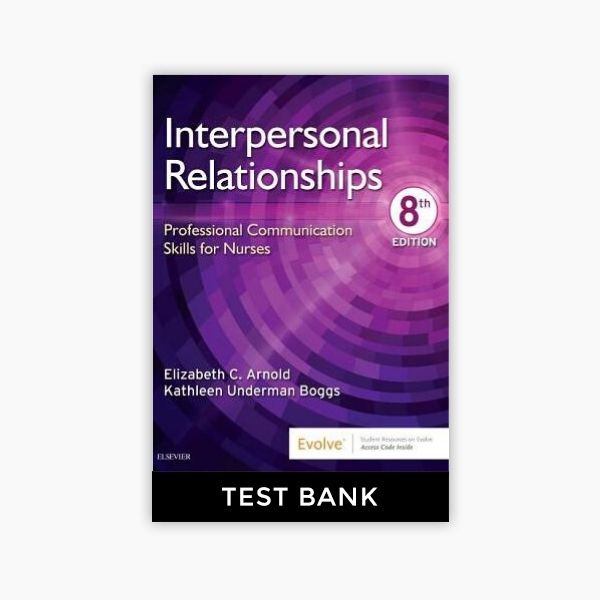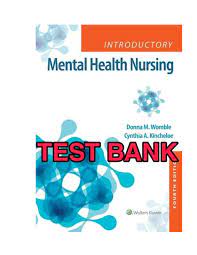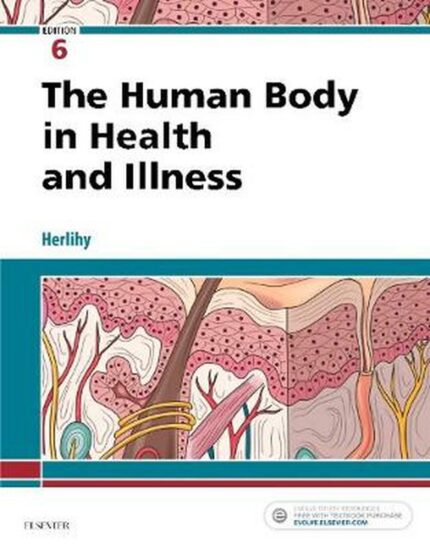Test Bank For Interpersonal Relationships 8th Edition Arnold
Chapter 1: Theory Based Perspectives and Contemporary Dynamics
MULTIPLE CHOICE
1. When describing nursing to a group of nursing students, the nursing instructor lists all of the
following characteristics of nursing except
a. historically nursing is as old as mankind.
b. nursing was originally practiced informally by religious orders dedicated to care of
the sick.
c. nursing was later practiced in the home by female caregivers with no formal
education.
d. nursing has always been identifiable as a distinct occupation.
ANS: A
Historically, nursing is as old as mankind. Originally practiced informally by religious orders
dedicated to care of the sick and later in the home by female caregivers with no formal
education, nursing was not identifiable as a distinct occupation until the 1854 Crimean war.
There, Florence Nightingale’s Notes on Nursing introduced the world to the functional roles
of professional nursing and the need for formal education.
DIF: Cognitive Level: Comprehension REF: p. 1
TOP: Step of the Nursing Process: All phases
MSC: Client Needs: Psychosocial Integrity
2. The nursing profession’s first nurse researcher, who served as an early advocate for
high-quality care and used statistical data to document the need for handwashing in preventing
infection, was
a. Abraham Maslow.
b. Martha Rogers.
c. Hildegard Peplau.
d. Florence Nightingale.
ANS: D
An early advocate for high-quality care, Florence Nightingale’s use of statistical data to
document the need for handwashing in preventing infection marks her as the profession’s first
nurse researcher.
DIF: Cognitive Level: Knowledge REF: p. 1
TOP: Step of the Nursing Process: All phases
MSC: Client Needs: Management of Care
3. Today, professional nursing education begins at the
a. undergraduate level.
b. graduate level.
c. advanced practice level.
d. administrative level.
ANS: A
Today, professional nursing education begins at the undergraduate level, with a growing
number of nurses choosing graduate studies to support differentiated practice roles and/or
research opportunities. Nurses are prepared to function as advanced practice nurse
practitioners, administrators, and educators.
DIF: Cognitive Level: Comprehension REF: p. 2
TOP: Step of the Nursing Process: All phases
MSC: Client Needs: Management of Care
4. Nursing’s metaparadigm, or worldview, distinguishes the nursing profession from other
disciplines and emphasizes its unique functional characteristics. The four key concepts that
form the foundation for all nursing theories are
a. caring, compassion, health promotion, and education.
b. respect, integrity, honesty, and advocacy.
c. person, environment, health, and nursing.
d. nursing, teaching, caring, and health promotion.
ANS: C
Individual nursing theories represent different interpretations of the phenomenon of nursing,
but central constructs—person, environment, health, and nursing—are found in all theories
and models. They are referred to as nursing’s metaparadigm.
DIF: Cognitive Level: Knowledge REF: p. 2
TOP: Step of the Nursing Process: All phases
MSC: Client Needs: Management of Care
5. When admitting a client to the medical-surgical unit, the nurse asks the client about cultural
issues. The nurse is demonstrating use of the concept of
a. person.
b. environment.
c. health.
d. nursing.
ANS: B
The concept of environment includes all cultural, developmental, and social determinants that
influence a client’s health perceptions and behavior. A person is defined as the recipient of
nursing care, having unique bio-psycho-social and spiritual dimensions. The word health
derives from the word whole. Health is a multidimensional concept, having physical,
psychological, sociocultural, developmental, and spiritual characteristics. The World Health
Organization (WHO, 1946) defines health as “a state of complete physical, mental, social
well-being, not merely the absence of disease or infirmity.” Nursing includes the promotion of
health, prevention of illness, and the care of ill, disabled, and dying people.
DIF: Cognitive Level: Application REF: p. 3
TOP: Step of the Nursing Process: Assessment
MSC: Client Needs: Psychosocial Integrity
6. A young mother tells the nurse, “I’m worried because my son needs a blood transfusion. I
don’t know what to do, because blood transfusions cause AIDS.” Which central nursing
construct is represented in this situation?
a. Environment
b. Caring
c. Health
d. Person
ANS: D
The concept of environment includes all cultural, developmental, and social determinants that
influence a client’s health perceptions and behavior. Caring is not one of the four central
nursing constructs. The word health derives from the word whole. Health is a
multidimensional concept, having physical, psychological, sociocultural, developmental, and
spiritual characteristics. The World Health Organization (WHO, 1946) defines health as “a
state of complete physical, mental, social well-being, not merely the absence of disease or
infirmity.” Nursing includes the promotion of health, prevention of illness, and the care of ill,
disabled, and dying people. Person is defined as the recipient of nursing care, having unique
bio-psycho-social and spiritual dimensions.
DIF: Cognitive Level: Application REF: p. 2
TOP: Step of the Nursing Process: Implementation
MSC: Client Needs: Psychosocial Integrity
7. The nurse performs a dressing change using sterile technique. This is an example of which
pattern of knowledge?
a. Empirical
b. Personal
c. Aesthetic
d. Ethical
ANS: A
Empirical knowledge is the scientific rationale for skilled nursing interventions. Personal
ways of knowing allow the nurse to understand and treat each individual as a unique person.
Aesthetic ways of knowing allow the nurse to connect in different and more meaningful ways.
Ethical ways of knowing refer to the moral aspects of nursing.
DIF: Cognitive Level: Comprehension REF: p. 5
TOP: Step of the Nursing Process: Implementation
MSC: Client Needs: Management of Care
8. The nurse-client relationship as described by Hildegard Peplau
a. would not be useful in a short-stay unit.
b. allows personal and social growth to occur only for the client.
c. facilitates the identification and accomplishment of therapeutic goals.
d. focuses on maintaining a personal relationship between the nurse and client.
ANS: C
Hildegard Peplau offers the best-known nursing model for the study of interpersonal
relationships in health care. Her model describes how the nurse-client relationship can
facilitate the identification and accomplishment of therapeutic goals to enhance client and
family well-being. In contemporary practice, Peplau’s framework is more applicable today in
longer-term relationships, and in settings such as rehabilitation centers, long-term care, and
nursing homes. Despite the brevity of the alliances in acute care settings, basic principles of
being a participant-observer in the relationship, building rapport, developing a working
partnership, and terminating a relationship remain relevant.






